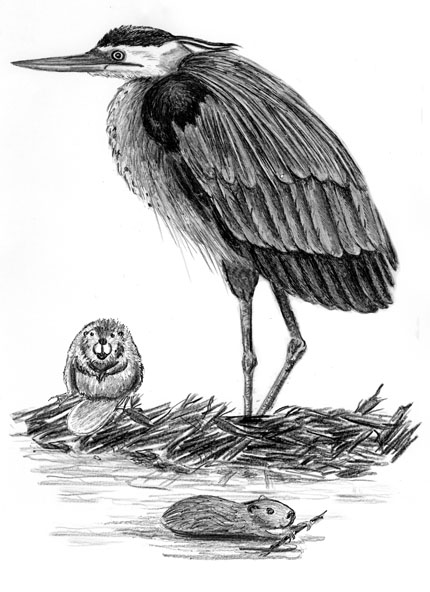
Dear Bird Folks,
I read in the paper that Massachusetts has seen a rise in the number of breeding Great Blue Herons and the reason for the growth is related to an increase in the local beaver population. What do herons need beavers for? They don’t eat them, do they?
– Rob, Worcester, MA
Yes, Rob,
Great Blue Herons love to eat beavers. They swallow them whole, devouring everything except for those big, flat tails, which they snip off and use for playing racquetball. Okay, fine. That’s not true. Sorry for being a wise guy, but sometimes it’s hard to tell if a question is sincere or if people are just messing with me. Of course herons don’t eat beavers. What herons love to eat are pancakes. They use the beaver tails as spatulas to flip the pancakes off the griddle. That’s the real story.
It is thought that the Bay State’s famed naturalist, Henry David Thoreau, never saw a Great Blue Heron nest in Massachusetts. Why? It’s partly because there were no beavers living in MA during Hank’s lifetime. Way back in the 1700s, unregulated cutting eliminated the trees beavers needed for survival. The beavers also had to deal with an endless number of hunters and trappers. Early settlers used beaver pelts for making hats (and used the beavers’ tails for flipping pancakes.)
Meanwhile, Great Blue Herons also found it hard to make it in Massachusetts. The dreaded millenary trade and lack of nesting sites eliminated these birds from the State. For centuries neither the heron nor the beaver bred in Massachusetts. Then, in 1928, a lone beaver was found living near Stockbridge (where it secretly worked as a model for Norman Rockwell). Under protection from the State, along with a few transplanted beavers from New York, our beaver population slowly started to rebound. In 1998, the little furbearers received more good news when the State outlawed those despicable leg hold traps. Today, beavers are once again thriving in MA. That’s not only great news for anyone who enjoys seeing beavers, but it’s great news for Great Blue Herons as well.
I think we all know how beavers operate. They find a secluded stream, cut down a few trees and dam it up. The area behind the dam becomes flooded and turns into a beaver pond. Why do beavers need to go through all the work to build their very own pond? The beavers create a pond so they can have underwater access to their lodge, even when everything is frozen in the winter. However, the newly built pond often entraps large trees, which eventually drown and die. Dead trees growing out of the center of a pond may look eerie to us, but they are magnets to herons. The dead trees provide excellent platforms for the birds to build their nests on. In addition, the water prevents terrestrial predators from munching on the eggs and babies. Between the swampy setting, the dead trees, the bulky stick nests and the gangly herons, the whole scene looks a Gothic nursery, but the birds love it.
Most of the year herons hate each other, but everything changes when the breeding season arrives. Pairs typically build their nests in a colony that is filled with other herons. Often they use the same nest that they used the year before. But if a better nest becomes available – perhaps because some elderly heron couple retired to Florida (which explains why Florida has so many herons) – the birds will readily take over the abandoned nest. The best spot for a nest is in the center of colony, where it is safer from predators, especially avian predators. Cornell’s Lab of Ornithology has a live webcam trained on a Great Blue Heron’s nest. This provides hours of entertainment for people with no lives. So, of course, I spent days watching it. On one occasion we could see the mother heron peacefully incubating her eggs…when bam! a Great Horned Owl attacked from behind. Not wanting to end up on the wrong end of the owl’s talons, the agile heron spun around and thrusted her long and very pointy beak at the attacker. It quickly became obvious why owls are called “wise.” The heron’s sharp beak caused the owl to wisely abort its assault. There would be no fresh heron on the menu this day. Instead, the owl was forced to eat at a nearby IHOP and wasn’t at all happy about it. Great Horned Owls hate pancakes.
Many of the Cape’s summer visitors expect to see herons feeding in the marshes and tidal flats, but herons are scarce around here this time of year. The Cape’s lack of heron nesting habitat means the majority of these birds are elsewhere in the State raising families. But come late August, when most people are leaving the Cape, the herons return. Smart birds.
After years of absence, Great Blue Herons now currently breed in many locations throughout the State, Rob, and a good portion of these habitats were created by hardworking beavers. It should be noted that not everyone is thrilled by the increasing number of herons. Folks who have backyard ponds get upset when hungry herons eat all of their fish. There are two common remedies for this problem. One is a motion-activated device that squirts water whenever anything walks in front of it. The other thing people can do to protect their ponds is to put out the heron’s favorite food in hopes of distracting the birds from eating the fish. What is the heron’s favorite food, you ask? Pancakes, of course. Weren’t you paying attention?